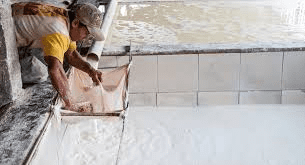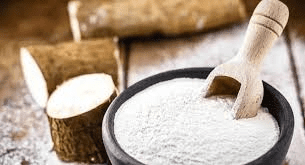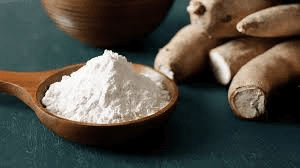Processing, packaging, and exporting cassava flour involves several essential steps to ensure that the final product is of high quality and ready for international markets. Cassava flour, made from the root of the cassava plant, is a versatile ingredient used in many cuisines worldwide. This guide will explain how to process, package, and export cassava flour in simple, easy-to-understand language.
The first step in the process is selecting high-quality cassava roots. It is important to choose fresh, healthy roots that are free from any damage, disease, or pests. The quality of the cassava roots directly affects the quality of the flour. Once selected, the roots are washed thoroughly to remove any dirt, pesticides, or other contaminants. Clean roots are essential to produce pure and safe flour.
After washing, the cassava roots are peeled to remove the thick outer skin. This step is crucial because the skin can contain toxins and is not suitable for consumption. The peeled roots are then chopped into smaller pieces to make them easier to handle and process. Uniform pieces ensure even drying and grinding, which is important for producing consistent flour.
The next step is drying the cassava pieces. Drying can be done using various methods, such as sun drying, oven drying, or using a mechanical dryer. Sun drying involves spreading the cassava pieces on drying racks and leaving them in the sun until they are completely dry. This method is cost-effective but requires a hot, dry climate. Oven drying and mechanical drying involve using controlled heat to dry the cassava pieces more quickly and consistently. Proper drying is essential to prevent mold growth and spoilage.
Once the cassava pieces are fully dried, they are ground into flour. This is done using a grinding machine or mill. The dried cassava pieces are ground into a fine powder, which is then sifted to remove any large particles or impurities. The result is smooth, fine cassava flour that is ready for packaging. Grinding and sifting are important steps to ensure the flour has the right texture and quality.
Packaging the cassava flour properly is crucial to maintaining its quality and extending its shelf life. The packaging must protect the flour from moisture, light, and air, which can cause spoilage and loss of quality. Common packaging options include plastic bags, paper bags, and vacuum-sealed bags. For larger quantities, cassava flour can be packed in bulk using food-grade barrels or sacks. The packaging should be done in a clean, dry environment to prevent contamination.
Labeling the packages accurately is important for consumer trust and regulatory compliance. The labels should include information such as the type of flour, ingredients, nutritional information, expiration date, and any certifications or quality marks. Clear and detailed labeling helps consumers make informed choices and ensures compliance with international trade regulations.
Exporting cassava flour involves meeting the quality standards and food safety regulations of the importing country. Exporters need to obtain necessary certifications and documentation to prove that the cassava flour is safe for consumption. This often includes health certificates, quality certificates, and certificates of origin. Exporters must also comply with packaging and labeling requirements specific to the destination country.
Transportation is a vital aspect of exporting cassava flour. The products must be transported in a way that maintains their quality and prevents spoilage. This usually involves using containers that protect the cassava flour from moisture and temperature fluctuations. Proper handling during loading and unloading is essential to avoid damaging the packages.
Upon arrival in the destination country, the cassava flour goes through customs clearance. This process involves inspecting the documentation and the products to ensure they comply with local regulations. If everything is in order, the cassava flour is cleared for entry and can be distributed to wholesalers, retailers, or directly to consumers.
Processing, packaging, and exporting cassava flour requires careful attention to detail at each stage. From selecting and preparing the cassava roots to drying, grinding, packaging, and meeting export regulations, every step is crucial to ensure the final product is of high quality and safe for consumption.
By following best practices and adhering to international standards, producers and exporters can deliver high-quality cassava flour to markets around the world, meeting consumer expectations and industry requirements. Proper handling, effective packaging, and reliable transportation are essential to ensuring that cassava flour reaches its destination fresh and ready to be enjoyed by consumers.
How to Process Cassava Flour for Exportation

1. Harvesting the Cassava Roots: Select mature cassava roots for the best quality flour. Harvest the roots when they are 9-12 months old for optimal starch content and minimal cyanide levels.
2. Washing and Cleaning: Thoroughly wash the harvested cassava roots to remove soil, dirt, and any other contaminants. Use clean, potable water and ensure that all surfaces of the roots are scrubbed clean.
3. Peeling: Peel the cassava roots to remove the outer skin, which contains most of the cyanogenic glucosides. Use sharp knives or mechanical peelers for efficiency. Ensure the peeled roots are free from blemishes and spots.
4. Grating: Grate the peeled cassava roots using a manual or mechanical grater to create a fine pulp. The grating process increases the surface area, making it easier to remove excess water and reduce cyanide levels.
5. Fermentation (Optional): Depending on the desired product, you may ferment the grated cassava pulp for 1-3 days. Fermentation helps reduce cyanide content and improve the flavor of the flour. Keep the pulp in a warm, covered environment to allow natural fermentation.
6. Pressing and De-watering: Press the grated cassava pulp to remove excess water. Use a mechanical press or hand wringer to squeeze out as much liquid as possible. This step is crucial to ensure the flour has a long shelf life.
7. Drying: Spread the pressed cassava pulp thinly on drying trays or clean surfaces. Dry the pulp under the sun or use a mechanical dryer. Ensure the drying area is clean and free from contaminants. The pulp should be dried to a moisture content of about 10-12%.
8. Milling: Once the cassava pulp is completely dry, mill it into fine flour using a hammer mill or another type of flour mill. Ensure the flour is finely ground to achieve a smooth texture.
9. Sieving: Sieve the milled cassava flour to remove any large particles or impurities. Use a fine mesh sieve for a consistent, high-quality product. Repeat the milling and sieving process if necessary to achieve the desired fineness.
10. Quality Control: Test the cassava flour for quality parameters such as moisture content, particle size, and cyanide levels. Ensure the flour meets the required standards for exportation. Conduct regular checks to maintain consistency.
11. Packaging: Pack the processed cassava flour in clean, moisture-proof bags or containers. Use food-grade packaging materials to maintain product quality. Seal the packages tightly to prevent moisture and contaminants from entering.
12. Labeling: Label the packages with essential information such as product name, net weight, production date, expiration date, and batch number. Ensure the labels comply with the regulations of the importing country.
13. Storing: Store the packaged cassava flour in a cool, dry place. Protect the storage area from pests, moisture, and direct sunlight to maintain the quality and shelf life of the product.
Read Also: Complete Composting Guide for Beginners
How to Package Cassava Flour for Exportation

1. Choosing Packaging Materials: Select high-quality, food-grade packaging materials that are moisture-proof and durable. Common options include multi-layer polyethylene bags, laminated pouches, or paper bags with inner plastic lining.
2. Labeling: Ensure each package is labeled with necessary information, including product name, net weight, production date, expiration date, and batch number. Compliance with the labeling regulations of the importing country is essential.
3. Packaging Design: Design attractive and informative packaging that highlights the quality and uniqueness of your cassava flour. Include your brand logo, nutritional information, and usage instructions to appeal to consumers.
4. Filling the Packages: Fill the packaging materials with the processed cassava flour using automated filling machines for accuracy and efficiency. Ensure the packages are filled to the correct weight and sealed properly to prevent spillage.
5. Sealing the Packages: Seal the packages securely using heat sealers or other sealing methods. Proper sealing ensures that the cassava flour remains fresh and free from contaminants.
6. Batch Coding: Implement a batch coding system on the packaging for easy tracking and traceability. Batch codes help identify specific production runs in case of recalls or quality issues.
7. Palletizing: Arrange the packed bags or containers on pallets for easier handling and shipping. Use stretch wrap or straps to secure the packages to the pallets, preventing shifting and damage during transport.
8. Temperature Control: Store and transport the packaged cassava flour at appropriate temperatures. Avoid exposure to extreme temperatures and humidity, which can affect the quality and shelf life of the product.
9. Quality Assurance: Conduct a final quality check on the packaged product before shipping. Verify that all packages are intact, labels are correct, and the cassava flour meets the required quality standards.
10. Documentation: Prepare all necessary documentation, including packing lists, invoices, certificates of origin, and any required export permits. Ensure all documents are accurate and comply with the regulations of the importing country.
11. Shipping Arrangements: Arrange for reliable shipping services. Choose a logistics provider experienced in handling food products to ensure safe and timely delivery to the destination.
How to Export Cassava Flour for Profits
1. Market Research: Conduct thorough research on potential export markets. Identify countries with high demand for cassava flour, favorable trade conditions, and potential competitors. Understanding market trends and consumer preferences is crucial.
2. Compliance with Regulations: Ensure compliance with both local and international regulations for food exportation. This includes obtaining necessary certifications, adhering to food safety standards, and meeting the labeling requirements of the importing country.
3. Certification: Obtain necessary certifications such as HACCP (Hazard Analysis and Critical Control Points), ISO (International Organization for Standardization) certifications, and any specific certifications required by the importing country. These certifications enhance credibility and facilitate market entry.
4. Pricing Strategy: Develop a competitive pricing strategy that covers production, packaging, shipping, and other costs while ensuring profitability. Analyze the pricing strategies of competitors and adjust your pricing to remain competitive while maintaining a healthy profit margin.
5. Building Relationships with Buyers: Network with potential buyers, including importers, distributors, and retailers in target markets. Establish strong relationships to secure long-term contracts and repeat business. Participate in trade shows, exhibitions, and online marketplaces to connect with potential buyers.
6. Negotiating Contracts: Negotiate clear and detailed contracts with buyers, including terms of sale, payment methods, delivery schedules, and responsibilities. Ensure that all terms are agreed upon to avoid disputes and ensure smooth transactions.
7. Managing Logistics: Plan and manage logistics for shipping cassava flour, including selecting reliable shipping companies, coordinating with freight forwarders, and managing documentation. Efficient logistics ensure timely delivery and product quality.
8. Marketing and Promotion: Create a marketing strategy to promote your cassava flour in international markets. Utilize online platforms, social media, trade shows, and industry publications to reach potential buyers and showcase your product’s quality and benefits.
9. Quality Assurance: Implement strict quality control measures throughout processing, packaging, and shipping. Consistently high-quality cassava flour builds trust and encourages repeat business. Address any quality issues promptly to maintain your reputation.
10. Monitoring Market Trends: Continuously monitor market trends, customer feedback, and sales performance. Be prepared to adapt your strategies based on changes in market conditions, consumer preferences, and emerging opportunities. Regularly review and refine your export plan to maximize profitability.
Read Also: What is the Best way to Grow Blueberries?
Frequently Asked Questions (FAQ’s) About Cassava Flour

1. What is cassava flour?
Cassava flour is a gluten-free flour made from the root of the cassava plant. It is used as a substitute for wheat flour in various recipes.
2. How is cassava flour different from tapioca flour?
Cassava flour is made from the whole cassava root, while tapioca flour is made from the starch extracted from the cassava root.
3. Is cassava flour gluten-free?
Yes, cassava flour is naturally gluten-free and is suitable for people with gluten intolerance or celiac disease.
4. What are the nutritional benefits of cassava flour?
Cassava flour is rich in carbohydrates, fiber, and essential vitamins and minerals like vitamin C and manganese. It is also low in fat.
5. How can cassava flour be used in cooking and baking?
Cassava flour can be used in a variety of recipes, including bread, cakes, cookies, and pancakes. It can also be used as a thickening agent in soups and sauces.
6. What is the shelf life of cassava flour?
When stored in a cool, dry place, cassava flour has a shelf life of up to one year. Proper storage in airtight containers can extend its shelf life.
7. Are there any health concerns associated with cassava flour?
Cassava contains natural cyanogenic glucosides, which can be toxic if not properly processed. Ensure that cassava flour is made from thoroughly processed cassava roots to remove these compounds.
8. Can cassava flour be used in a low-carb diet?
Cassava flour is high in carbohydrates and may not be suitable for a low-carb diet. However, it is a good option for those looking for a gluten-free flour alternative.
9. What are the best storage conditions for cassava flour?
Store cassava flour in a cool, dry place in airtight containers to prevent moisture absorption and contamination. Avoid exposure to direct sunlight and humidity.
10. Where can I buy cassava flour?
Cassava flour can be purchased at health food stores, specialty grocery stores, and online retailers. Look for reputable brands that ensure high-quality and safe processing.
Read Also: How to Start an Urban Farm






